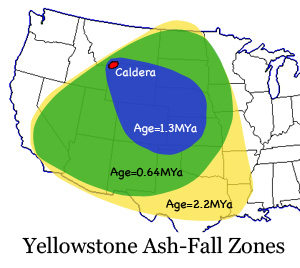That’s not really the same thing, though. We’re technically due (though not really “overdue”) because the last one was 640kya and the recurrence interval seems to be 600k-800k years, but you’re still talking about something where the chances of it happening in any given human lifespan are a few thousand to one. With major earthquakes, the recurrence intervals are mere centuries and you’re talking single digit probabilities. In the case of some that are truly overdue, they may even be more likely than not.
And just to add to that, unless you are claiming Yellowstone’s eruption is equivalent to Old Faithful, there’s no guarantee that this apparent cycle will be repeated, ever.
Well, it has been doing it for the last 16 million years or so. Mantle plumes (if that is indeed what Yellowstone is) aren’t entirely understood, but it seems likely that the observed trend will continue.
Oddly enough, the caldera eruption interval of 700,000 years +/- 100k has an uncertainty similar to Old Faithful, which is currently about 80 minutes +/- 10!
Part of he OP’s question as I interpret it is also what happens after the Big One. Can LAFD put out the fires or will they let them burn? How will LAPD and the Sheriff’s Office prioritize/respond to emergencies? Shoot all looters on sight? What are Caltrans’ plans for the freeway/roadways? I know LAUSD’s plan was (probably still is) is to have teachers stay up to 72 hours with the students while they get picked up. What happens after 72 hours?
After 72 hours we can start eating those that haven’t been picked up. 
You obviously haven’t seen my son’s room.
The chance of the Yellowstone supervolcano going off in any one year is 0.00014%. The chance of a 7+ earthquake on one of the faults near Yellowstone is a thousands times greater (0.125%). But the supervolcano would be a lot cooler (except for those living nearby).
In that particular case, wouldn’t “nearby” take on a whole new meaning?
“Nearby”, give or take 500 miles.
Are they ready for the banks of the L.A. River to break, flooding . . .
. . . sorry, I’ve got nothing.
nope
I’m coming, Elizabeth
Thanks.
Well, just imagine your son’s room times several million and you have the visual.
That’s a big-ass area. You might not think it, but it is. A 500 mile circle from where I am, in Minneapolis, stretches nearly all the way across South Dakota, down to St. Louis (a 9 hour drive from here!), east to nearly Ohio (the entire upper mitten of Michigan), and north almost halfway to Hudson Bay in Canada. A 500 mile radius circle from Yellowstone encompasses all of Idaho, Montana (Montana!), and Wyoming; most of Utah and Colorado; half of Washington, Oregon, Nevada and North and South Dakota; about a third of Nebraska; and good bits of Saskatchewan and Alberta. It’s probably a third of the contiguous US, not counting Alaska.
No argument, it’s a big area, especially compared to usual volcano impacts. A radius of 500 miles is not quite a third of the continental U.S. (3.12 million square miles), but it’s around 20% depending on how much of that radius extends into Canada. I can speak facetiously of “nearby” because I am just outside that range. 
The 500-mile disaster radius is mostly due to falling ash. The definition I saw for “disastrous” is a layer more than 10 cm. The zone with actual lava flows is “only” 30-40 miles (which is still pretty honkin’ massive).
Recent LA Times article about potentially dangerous non-retrofitted buildings:
Thousands of lives at risk and L.A.'s quake retrofit law isn't helping
Those interested can Google Images “Yellowstone eruptions ash map” or similar, and compare the impact maps for St. Helens 1980 vs. Yellowstone’s last big one 600k years ago.
Boy, howdy it would!
The “Lava Creek” eruption of Yellowstone approximately 630,000 years ago spread ash from mid-Missouri to out past California into the Pacific Ocean, and the north-south spread was from the current US/Mexican border almost all the way up to Canada.
The “Huckleberry Ridge” eruption about 2 million years ago had an east-west spread from Missouri/Arkansas/Louisiana all the way back to California, and north-south from southern Texas almost all the way up to Canada.
There is some evidence that at least one eruption of Yellowstone deposited ash as far east as Chicago, but that’s a bit shakier than the above.
That’s just the ashfall, it doesn’t count other effects, which will be global.
Everything within about 40 miles of Yellowstone will probably be vaporized. Everything 300-500 miles away, especially downwind, will probably die (if people can get out of that zone quickly enough they might survive… but inhaling volcanic ash can be like inhaling glass shards, it’s Very Bad for your health and can kill you). Agriculture in North America just won’t happen for a few years. The North American breadbasket will be out of commission. Anyone depending on it for food will starve. Food is going to get scare everywhere. Yeah, if you’re watching it on the BBC from London it will be “cool”… until suddenly you’re having trouble getting enough to eat, the weather is even more screwed up than it is now, and you have North American refugees trying to sneak onto your shores. Rinse and repeat pretty much everywhere.
For a thumping good Yellowstone eruption “nearby” pretty much means “North American” and “those affected” means “everyone”.
Although a big earthquake near Yellowstone could be pretty cool if you’re a tourist. After the 1959 Hebgen Lake earthquake, about 300 of the geysers went off at once, including ones that hadn’t ever had a recorded eruption and some of which erupted continuously for weeks.

